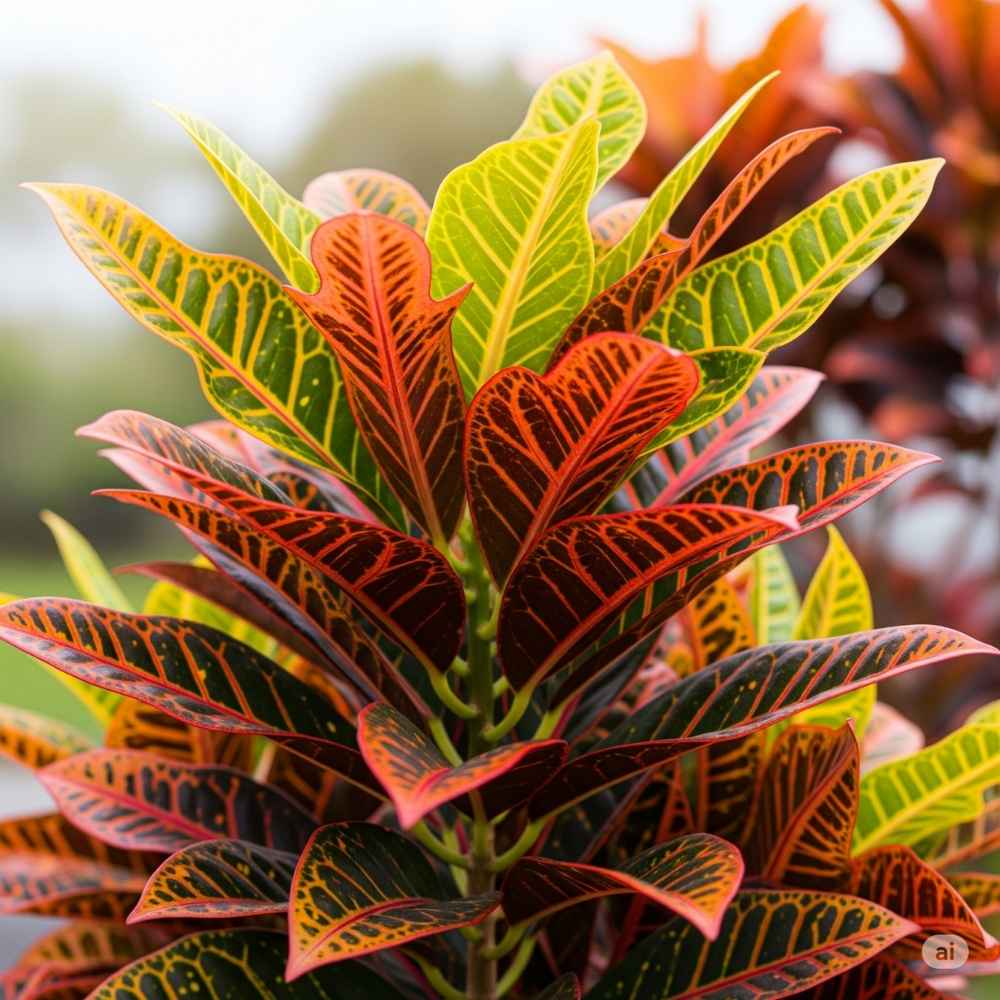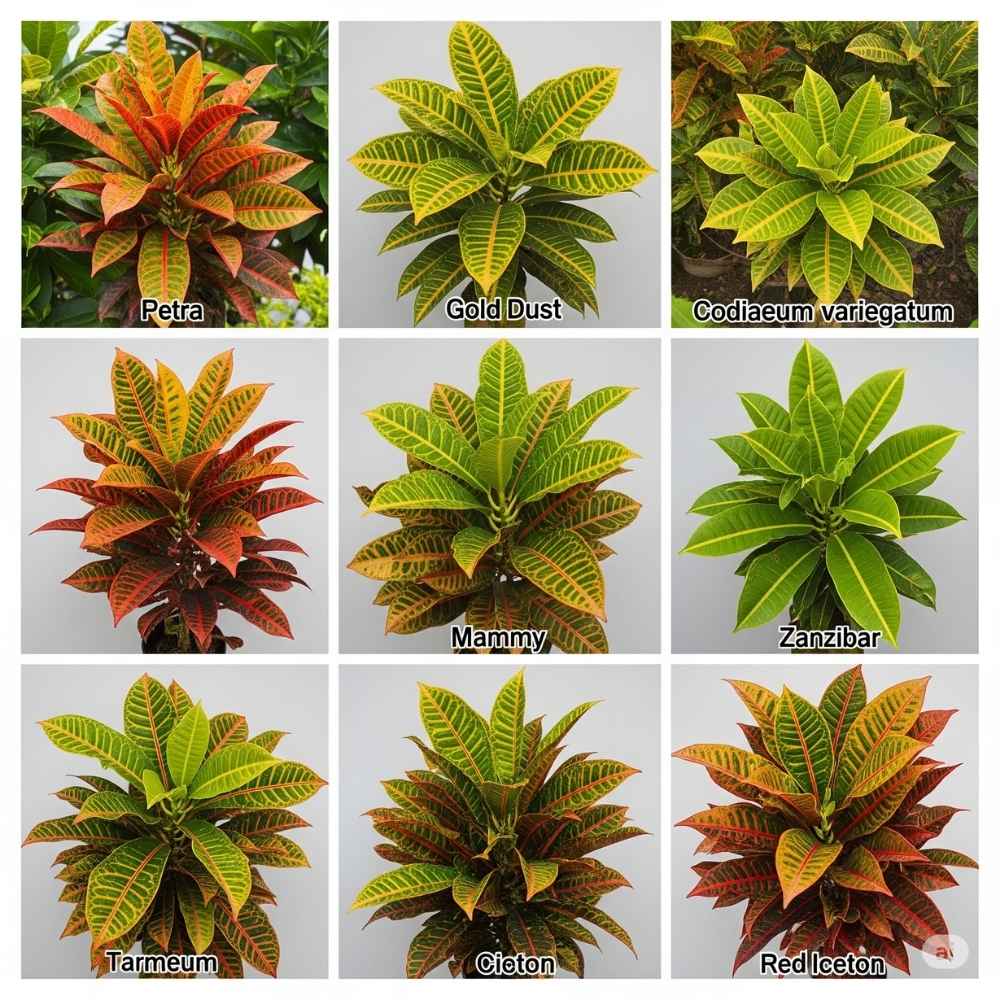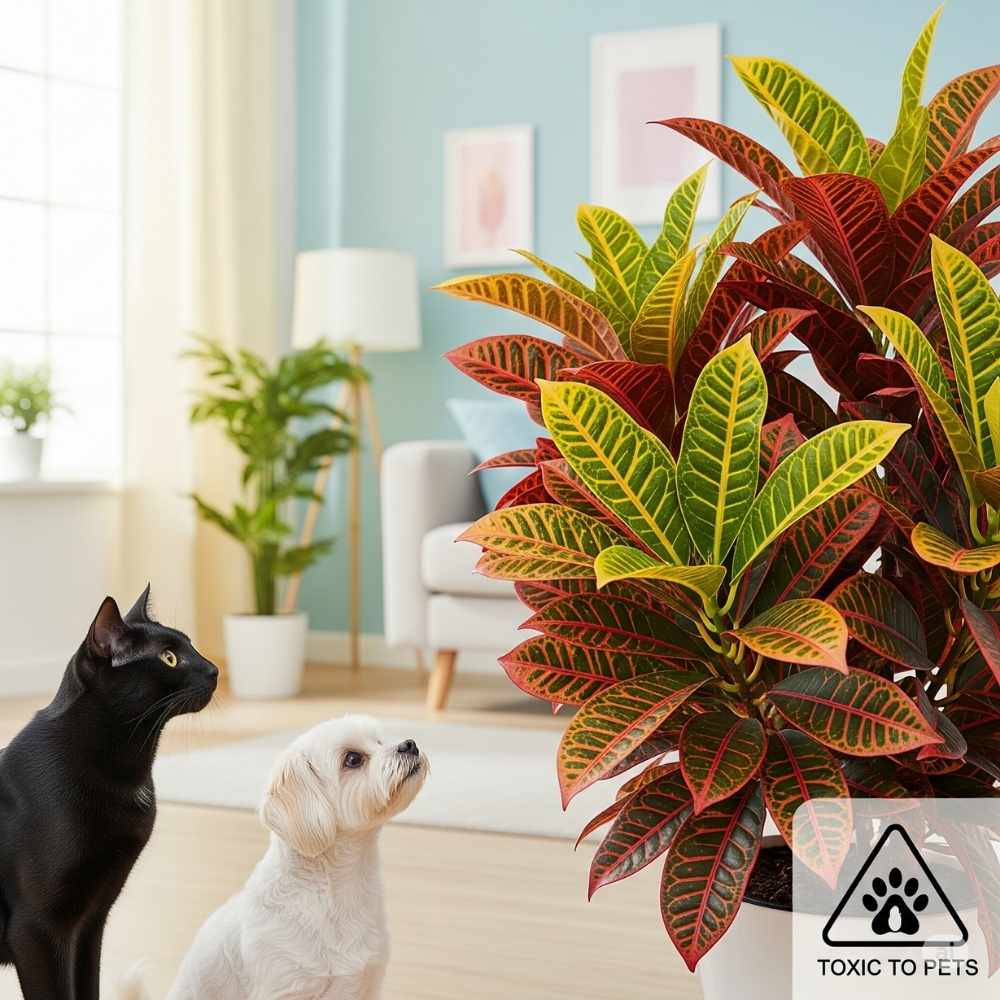Croton Plant: Your Home’s Fiery Superstar of Color!
Imagine a plant that looks like a living rainbow, bursting with fiery reds, oranges, yellows, and greens all on one leaf! That’s the amazing Croton plant (Codiaeum variegatum). This stunning beauty is like a natural fireworks display, bringing incredible, vibrant color and a bold, tropical feel to any room.
Hailing from the warm, sunny islands of Southeast Asia, Crotons are cherished for their absolutely breathtaking foliage. They might seem a little bit “high maintenance” at first glance, but once you understand their few key needs, they become truly rewarding plants that bring so much joy and visual pop to your home. Let’s discover the diverse and colorful world of Crotons. Let’s explore everything you need to know to make your Croton truly shine!
What Makes a Croton Plant So Unique? Its Fiery Leaves and Bold Presence

When you first see a Croton, you’ll be mesmerized by its leaves. They’re thick, leathery, and incredibly glossy, but it’s their color that truly captivates. Each leaf can be a wild mix of reds, oranges, yellows, greens, and even hints of black or purple, all splashed and streaked together. You might see cool patterns along the veins, spots, or vibrant margins.
What’s truly unique about Crotons is how dramatic their color can be. The more bright light they get, the more vibrant and intense their colors become – it’s like magic! They don’t have showy flowers; their beauty is all in that spectacular foliage, making them a stunning statement piece in any room.
Where Do Croton Plants Come From? Southeast Asia’s Sunny Tropics
Your Croton plant’s ancestors originally come from the sunny, open forests and coastal areas of Malaysia, the Pacific Islands, and Indonesia. In their natural homes, they bask in lots of bright light. This tropical background is a huge clue about what they need to look their best indoors – plenty of sunshine to fuel those amazing colors!
What Are Its Other Names? “Garden Croton” and Why It’s So Vibrant
The most common name for Codiaeum variegatum is simply “Croton” or sometimes “Garden Croton.” It’s good to know its scientific name, Codiaeum variegatum, because there’s actually another plant called “Croton” (from a different genus, Croton) that looks nothing like it! The reason your Croton is so vibrant and fiery is directly linked to how much light it gets – it literally paints its leaves with sunshine!
What Kinds of Croton Plants Are There?
The world of Crotons is like a living kaleidoscope! While they all share that amazing colorful spirit, you’ll find them in a huge variety of leaf shapes, patterns, and color combinations.

Popular Croton Types: A Kaleidoscope of Foliage
- ‘Petra’: This is a super popular and classic choice. Its broad, oval leaves boast fiery red, orange, and yellow veins that create a striking contrast with the deep green background, making it truly captivating.
- ‘Gold Dust’: This one is adorable! Its dark green leaves appear to be dusted with bright yellow or gold speckles, which perfectly explains its name.
- ‘Mammy’: Get ready for some fun! ‘Mammy’ Crotons have unique, narrow leaves that twist and curl, showing off a vibrant mix of red, orange, and green. They’re very playful.
- ‘Oakleaf’: Just like the name suggests, this variety has leaves shaped similar to an oak leaf, with beautiful autumnal colors.
- ‘Zanzibar’: This type is striking with its very narrow, almost grassy leaves that explode with a mix of green, red, orange, and yellow hues. It has a very different texture.
Leaf Looks: Colors, Patterns, and Shapes
The diversity in Croton leaves is truly incredible. You’ll find leaves that are oval, narrow, deeply lobed like an oak leaf, or even wonderfully twisted and curly. But it’s the color party that really stands out! Think bold veins, delicate spots, contrasting edges, and fiery splashes all on one leaf. It’s endlessly fascinating to see the unique patterns each leaf creates.
Growth Habit: Bushy and Upright
Croton plants typically grow as upright, bushy shrubs, making them fantastic floor plants or colorful centerpieces on large tables. Their dense foliage creates a lush and vibrant presence in any space.
How Do You Take Care of Your Croton Plant?
Crotons have a reputation for being a bit “fussy,” but honestly, once you know their few key desires, they’re wonderfully rewarding. The secret? Consistency and lots of light!

The Right Light: Bright, Direct Light for Best Color!
This is the most crucial tip for a vibrant Croton: they absolutely need bright, direct sunlight to show off their best colors! For optimal growth, ensure the plant receives at least 3-6 hours of direct sunlight daily, with a south or west-facing window being the most suitable location. If your Croton starts looking dull and its bright colors fade to plain green, it’s a clear sign it’s not getting enough light. So, place it where it can truly soak up those rays!
Watering Smart: Consistently Moist, But Not Soggy!
Crotons are a bit like Goldilocks when it comes to water – not too dry, not too wet, but just right! They prefer their soil to be consistently moist, especially during the growing season. Water thoroughly when the top inch (about 2.5 cm) of soil feels dry to the touch. Don’t let the soil completely dry out, as they’ll start drooping dramatically, but definitely avoid soggy conditions, which can lead to root rot. Good drainage is key!
Cozy Temperatures and High Humidity, Please!
Just like their tropical home, Crotons crave warm temperatures, ideally between 60-85°F (15-29°C). They really dislike cold drafts and sudden temperature changes, so keep them in a snug, stable spot! And humidity? Oh, they absolutely adore high humidity! If your indoor air is dry (especially with winter heating), you’ll often see those annoying brown, crispy edges on their leaves. To make them feel right at home, consider using a humidifier, placing the pot on a pebble tray with water, or giving them a light misting regularly.
Choosing the Right Soil and Pot: Drainage is a Must!
Your Croton will be happiest in a well-draining, rich potting mix that still holds onto some moisture. A good quality indoor potting mix works well. And, as always, make sure your pot has fantastic drainage holes to prevent soggy roots. Crotons don’t need super frequent repotting; they usually like to be a bit snug. Repot only when they’re clearly root-bound, usually every 1-2 years, ideally in the spring.
Feeding Your Croton: Regular Meals During Growing Season
To fuel all that amazing color and growth, your Croton will appreciate regular feeding during its active growing season (spring and summer). Use a balanced liquid houseplant fertilizer, diluted to half strength, every month or so. When fall arrives and winter sets in, you can stop feeding entirely.
What Are Common Problems with Croton Plant and How to Fix Them?
Crotons are expressive, and sometimes that means a dramatic leaf drop! Here’s what to watch out for and how to help your plant feel better:
Leaf Drop: A Sign of Stress!
This is the most common (and alarming!) issue with Crotons. If your plant suddenly starts dropping leaves, it’s almost always a sign of stress. This can be caused by:
- Sudden changes: Moving it to a new spot, a drastic temperature drop, or cold drafts.
- Watering extremes: Either letting it get too dry or, more commonly, overwatering.
- Low humidity: Especially in dry indoor air.
- The Fix: Try to provide a stable environment. Keep watering consistent. Boost humidity. Be patient – it often bounces back once it adjusts!
Fading Colors: Not Enough Light
If those fiery reds and oranges start looking dull, muted, or turn mostly green, your Croton is telling you it’s not getting enough light.
- The Fix: Move your plant to a brighter spot where it can get more direct sun. Its colors should intensify over time.
Brown, Crispy Edges/Tips: Usually Low Humidity or Underwatering
You’ll often see browning and crisping on the edges or tips of leaves as an indicator of inadequate humidity or that the plant is allowed to dry out too much between waterings.
The Fix: Increase humidity around the plant (humidifier, pebble tray) and ensure you’re watering consistently, never letting the soil get bone dry for too long.
Yellowing Leaves: Often Overwatering
If your Croton’s leaves are turning yellow, especially the older ones, it’s frequently a sign of overwatering. The soil is staying too wet, and the roots are struggling.
- What to do: Check your watering habits. Ensure the soil dries sufficiently between watering sessions.
Pesky Pests: Watch Out for Spider Mites!
Crotons are unfortunately quite susceptible to spider mites, especially in dry indoor conditions. Tiny webs or speckled leaves can be noticeable signs. Mealybugs and scale can also be an issue.
- The Fix: To keep your plant healthy, routinely examine it, focusing on the bottoms of the leaves. If pests are present, act quickly by applying insecticidal soap or neem oil. Remember that higher humidity can also serve as a deterrent for spider mites.
Root Rot: The Big Danger of Overwatering
This is a serious problem caused by soil that stays wet for too long, leading to the roots literally rotting away.
- The Fix: Prevention is key – always ensure excellent drainage and allow the soil to dry out between waterings. If you suspect root rot (mushy stems, foul smell), you might need to repot it into fresh, dry soil after trimming any unhealthy roots.
Is the Croton Plant Toxic? Safety for Pets

Yes, it’s very important to know: Croton plants are considered toxic if ingested. They contain irritating sap and certain compounds (like alkaloids and saponins) that can cause significant discomfort.
If your cats, dogs, or other pets chew on a Croton, you might see symptoms like:
- Oral irritation and pain: You might observe them pawing at their mouth, drooling profusely, or exhibiting other indicators of distress.
- Vomiting: This is a common reaction after ingestion.
- Diarrhea: Due to digestive upset.
While usually not life-threatening, it can be very uncomfortable for your pets. For safety, ensure Croton plants are kept out of the reach of both pets and small children. If you think your pet has eaten any part of a Croton and shows symptoms, please contact your veterinarian immediately for advice.
Croton Plant for Home Decor: A Burst of Bold Color
The Croton plant is an absolute showstopper for home decor, guaranteed to add drama and vibrancy to any room:

Creating a Statement Piece
With its incredibly colorful leaves, a Croton can instantly become the boldest statement piece in your home. It draws the eye and adds a tropical, artistic flair to any corner.
Perfect for Sunny Spots
Since it absolutely thrives on bright light to maintain its amazing colors, the Croton is perfect for those sunny windowsills, bright corners, or well-lit rooms where it can truly bask and show off.
Adding a Tropical or Eclectic Vibe
Its exotic looks and riot of colors make it a natural fit for tropical-themed decor or for adding a touch of eclectic charm to a space. It feels like bringing a piece of the sunny tropics right inside!
Complementing Warm Color Palettes
The reds, oranges, and yellows in a Croton’s leaves make it a fantastic plant to complement rooms with warm color schemes, adding depth and richness to your interior design.
The Allure of Croton Plant: Fiery, Fascinating, and Full of Life
The Croton plant is truly a captivating addition to any plant collection. It offers a unique blend of dramatic, fiery colors, intricate leaf patterns, and the rewarding experience of watching its hues intensify with light. While it asks for a bit more attention to light, water, and humidity than some other houseplants, the vibrant payoff is absolutely worth it. It’s a bold declaration of nature’s artistry, bringing warmth, fascination, and undeniable life into your home.
Frequently Asked Questions (FAQ) About Croton Plant
Got more questions about your colorful Croton? Here are a few frequent occurrences to be aware of.
Q1: Why do my Croton leaves keep falling off?
A1: Crotons are famous for dropping leaves when they’re stressed by sudden changes. This could be moving it to a new spot, a sudden temperature drop (especially cold drafts!), too much or too little water, or very low humidity.
- The Fix: Try to keep its environment as stable as possible. Give it consistent care, and it will usually adjust and bounce back, though it might take a little time.
Q2: How much light does a Croton need?
A2: Crotons need bright, direct sunlight for several hours a day (3-6 hours is ideal) to maintain their vibrant colors. If they don’t get enough light, their colors will fade and look dull, often turning mostly green.
Q3: How often should I water my Croton?
A3: Water your Croton when the top inch (about 2.5 cm) of soil feels dry to the touch. They like to be consistently moist, but never soggy. It’s a balance – don’t let them dry out completely, but don’t drown them either!
Q4: Why are my Croton’s colors fading or turning green?
A4: This is a clear sign that your Croton isn’t getting enough light. The vibrant reds, oranges, and yellows need plenty of bright, direct sunlight to develop and stay intense.
- The Fix: Place your plant in a location that receives more sun.
Q5: Is it hard to care for a Croton?
A5: Crotons are often considered moderately challenging compared to super easy plants like Pothos or Snake Plants. They have specific needs for light and humidity, and they can be a bit sensitive to changes. But once you get their routine down, they’re quite rewarding!
Q6: Are Croton plants toxic to pets?
A6: Indeed, Croton plants are toxic if consumed by cats, dogs, and other household pets.They contain irritating compounds that can cause oral pain, vomiting, and diarrhea. For their safety, ensure they are placed beyond the reach of curious pets.
Q7: How can I prevent spider mites on my Croton?
A7: Crotons are quite susceptible to spider mites, especially in dry conditions.
- Prevention: Increase humidity around your plant. Make sure to inspect the leaves often, focusing on the lower surfaces.
- Treatment: If you spot them, wipe down the leaves with a damp cloth, or use insecticidal soap or neem oil.
Q8: When should I repot my Croton?
A8: Crotons don’t need to be repotted very often, usually only every 1-2 years or when they become clearly root-bound (roots growing out of drainage holes). It’s generally best to repot during the spring.
Q9: Can a Croton plant live in a bathroom?
A9: A bathroom can be a good spot for a Croton if it gets ample bright, direct light. The humidity from the bathroom will be a huge plus for it. However, if your bathroom is dim, it won’t be a good fit for a Croton despite the humidity.





